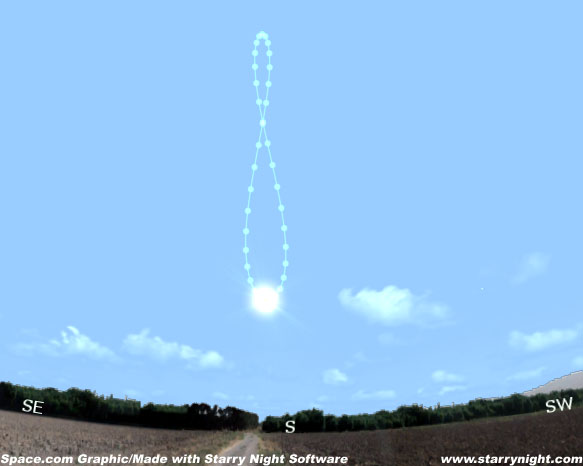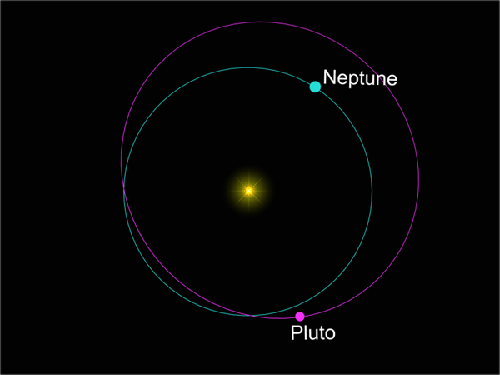Figure A. The noontime position of the Sun in the sky, plotted over a year, produces a figure eight-shaped curve known as the analemma. Earth's elliptical orbit produces the curve of the analemma. Its lowest and highest points are, respectively, the winter and summer solstices. The vertical line running through the analemma is the meridian. This view shows the Sun at noon on 4 January 2007, the day of perihelion -- Earth's closest approach to the Sun.

1 posted on
11/09/2025 9:52:29 PM PST by
SunkenCiv
To: SunkenCiv
There are many things that I have a problem understanding...
because they seem to contradict each other.
This is one of them.
There are others...
I understand that the moon causes a high tide when it passes overhead (gravitational influence)
but knowing that,
I do not understand why that causes a 2nd high tide on the opposite side of the earth.
I understand why hot air rises and cold air settles (buoyancy)...
but knowing that,
I do not understand why the beach is hot and the mountain tops are cold.
I understand why wind impacting you makes you feel cooler (wind chill),
but knowing that,
I do not understand why meteorites and returning spacecraft get hot when they impact the atmosphere.
7 posted on
11/09/2025 10:15:33 PM PST by
Repeal The 17th
(Get out of the matrix and get a real life.)
To: SunkenCiv
Sunlight heats the ground, and the ground in turn heats the air. In summer the sun is higher in the sky, so it heats the ground more effectively. The sun’s angle in the sky varies by 23.5 degrees, while the sun’s distance varies by only 0.34%.
To: SunkenCiv
I reckoned you posted this
Didn’t know this factoid
I woulda guessed opposite
12 posted on
11/09/2025 11:09:53 PM PST by
wardaddy
(If u hate Trump you’re oh eff offstupid or clueless what’s going on)
To: SunkenCiv
Lucy’s football.
That’s why.
14 posted on
11/09/2025 11:31:04 PM PST by
Jonty30
(I've been diagnosed as being polemic and there is no cure. )
To: SunkenCiv
Same question and answer: Why do you get closer to the fireplace during those winter evenings?
16 posted on
11/10/2025 12:13:50 AM PST by
SuperLuminal
(Where is rabble-rising Sam Adams now that we need him? Is his name Trump, now?)
To: SunkenCiv
If you plot the noontime position of the Sun in the sky over a one-year period, it produces a figure-eight shape on the sky (Figure A). This is the analemma.
Yeah...not a fan of anal enemas...
18 posted on
11/10/2025 3:17:57 AM PST by
Adder
(End fascism...defeat all Democrats.)
To: SunkenCiv
This would not be a good time for a manned mission to the sun!
To: SunkenCiv
When you get cold 🥶🥶🥶
You get closer to the heater 🔥🥵
😃😄😂🤣😁
20 posted on
11/10/2025 3:36:49 AM PST by
SaveFerris
(Luke 17:28 ... as it was in the Days of Lot; They did Eat, They Drank, They Bought, They Sold ......)
To: SunkenCiv
The difference between the two is 5,003,451 km, (3.3 percent), and not enough to cause the seasons. Yeah, but lets bring the Milankovitch Cycle into the mix and talk about ice ages.

22 posted on
11/10/2025 3:50:17 AM PST by
Sirius Lee
("Never argue with a fool, onlookers may not be able to tell the difference.d)
To: SunkenCiv
I’ve long maintained that anyone who believes the “man-made climate change” hoax has never toasted a marshmallow over a campfire.
Facts the author(s) might have included:
Neither the speed of the Earth’s rotation on it’s axis nor the speed of it’s orbit around the Sun are constant.
Also, the Earth “wobbles” a bit as it spins.
23 posted on
11/10/2025 4:07:34 AM PST by
Ignatz
("Look, if I offend anybody today, I don't care." -Tom Homan)
To: SunkenCiv
This is simple. The thing I struggle with is how we only see one side of the moon.
24 posted on
11/10/2025 4:09:47 AM PST by
Buttons12
( )
To: SunkenCiv
This reads like it was written for 6 year olds. I hate it when these science journalists dumb everything down to the point that it’s only words and no actual science.
To: SunkenCiv
Thanks for posting.
The analemma plays into the optimum angle for solar panels. People with ground mounted solar panels often have a hinge they can pivot (maybe twice per year) to point closer to straight up during the summer. Then during the winter lower the angle to point the panels closer to the horizon. The idea is that the solar panels work best when the sunlight hits the panel at 90 degrees.
28 posted on
11/10/2025 4:54:43 AM PST by
Tell It Right
(1 Thessalonians 5:21 -- Put everything to the test, hold fast to that which is true.)
To: All
A circle is a special case of ellipse but all orbits (in a 2-body system) are (non-circular) ellipses because gravitational forces are not distributed evenly throughout the universe, and over time even tiny differences in gravity will cause orbits to gain eccentricity.
We might hang a satellite in orbit in a perfectly circular orbit but even if the earth and that satellite were the only objects in the universe, the surface of the earth is not cue-ball smooth, and those irregularities cause differences in gravitational pull, which, over time, would cause the orbit to become eccentric. So in every case, eccentricity is inevitable.
You could use thrusters to keep it (sort of) circular but you'd have to burn fuel to do it, and refuelling satellites is an expensive proposition, so they tend to let grabity have its way.

Pluto's orbit is so eccentric, it sometimes is closer to the sun than Nepture is.
To: SunkenCiv
That is a really cool illustration! I have never seen anything like it before now. Thanks!
42 posted on
11/10/2025 6:08:19 AM PST by
GingisK
To: SunkenCiv
Why Earth is Closest to Sun in Dead of Winter This seems to be a very Northern Hemisphere-centric point of view; in the "dead of winter" in the Northern Hemisphere, it is the dead of summer in the Southern Hemisphere.
47 posted on
11/10/2025 6:35:40 AM PST by
Lou L
(Health "insurance" is NOT the same as health "care")
To: SunkenCiv
The Sun’s cycle is an approximately 11-year period of solar activity, during which its magnetic field reverses polarity. This cycle includes a rise from a minimum to a maximum, characterized by increasing numbers of sunspots, solar flares, and coronal mass ejections, followed by a decline back to a minimum. The cycle affects Earth’s space weather, which can impact power grids, communication systems, and satellites.
49 posted on
11/10/2025 7:22:58 AM PST by
Vaduz
To: SunkenCiv
“Earth's orbit is not a perfect circle. It is elliptical, or slightly oval-shaped. This means there is one point in the orbit where Earth is closest to the Sun, and another where Earth is farthest from the Sun.”
And the Sun is at a foci of this elliptical path. If the Sun was in the center there would be two times the earth is far away and two times it is close each year.
The path is only slightly elliptical, which is another reason it does not cause seasons.
50 posted on
11/10/2025 8:40:22 AM PST by
unlearner
(See my about page for "God's Promises During Tribulation".)
To: SunkenCiv
The difference between the two is 5,003,451 km, (3.3 percent), and not enough to cause the seasons.
~~~~~
But, as Milankovitch pointed out, the difference is great enough to cause ice ages every 100,000 years when orbital precession causes earth’s northern hemisphere to point at the sun during its summer in earth’s orbital perihelion.
Look for it out of your cave opening in 50,000 years.
53 posted on
11/10/2025 10:46:32 AM PST by
nagant
FreeRepublic.com is powered by software copyright 2000-2008 John Robinson


